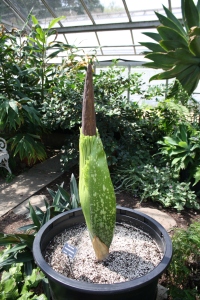I used to hesitate when trying to decide if a tree needed to be cut down. But not any more! Both the Botanical Gardens and my home garden have become significantly shadier in the past few years. It’s inevitable if there are trees around! And while trees are important, not to mention beautiful, if there’s anything else you would like to grow, the trees have to go. I love them for their sense of permanence, their cool shade in summer, their habitat for birds and wildlife. For firewood, autumn leaves, and fruit. I curse them when I want to grow tomatoes, sunflowers, strawberries or corn!
 This part of the garden was adapted long ago to the trees which tower over it. A thriving shady border, with plants that love the cool and moist soil. It’s a case of “if you can’t beat ’em, join ’em” for a dedicated gardener! But if you can “beat ’em”, if they are not your neighbor’s trees, not historically or environmentally significant, beloved perhaps but not necessarily important, then she who hesitates is lost. Cut down the trees, make yourself a sunny spot, and let your garden grow.
This part of the garden was adapted long ago to the trees which tower over it. A thriving shady border, with plants that love the cool and moist soil. It’s a case of “if you can’t beat ’em, join ’em” for a dedicated gardener! But if you can “beat ’em”, if they are not your neighbor’s trees, not historically or environmentally significant, beloved perhaps but not necessarily important, then she who hesitates is lost. Cut down the trees, make yourself a sunny spot, and let your garden grow.
 AUDREY UPDATE: August 31, 2012
AUDREY UPDATE: August 31, 2012
 Over the past two days Audrey’s growth has slowed. Instead of 3 inches a day, it has been just one. Now at 51 inches, actual bloom time is drawing near! The bracts have fallen away, the spathe is coloring up around it’s frilled edge and all we have to do is wait. Check back with “Thoughts from the Garden” this weekend to get the latest photos of our tropical curiosity.
Over the past two days Audrey’s growth has slowed. Instead of 3 inches a day, it has been just one. Now at 51 inches, actual bloom time is drawing near! The bracts have fallen away, the spathe is coloring up around it’s frilled edge and all we have to do is wait. Check back with “Thoughts from the Garden” this weekend to get the latest photos of our tropical curiosity.




















